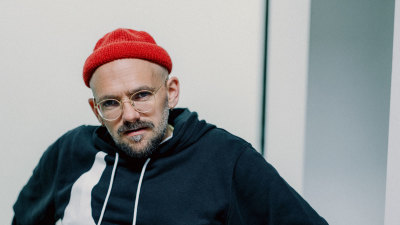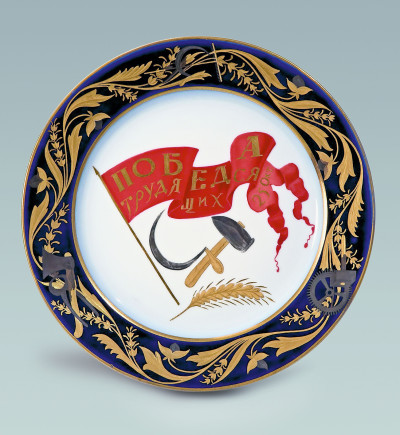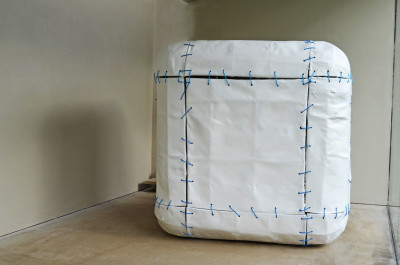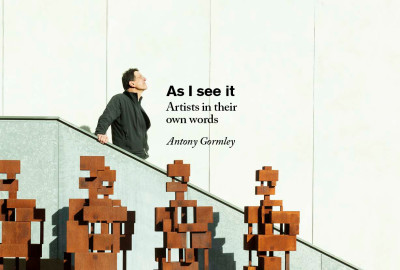My studio life: Edmund de Waal
My studio life: Edmund de Waal
By Harriet Baker
Published 25 September 2015
We visited Edmund de Waal in his south London studio, where he told us about creating a space for both making and writing.
-
“I’m a potter and I make pots. Everyone gets very posh about what they’re called but I like the simplicity of just calling myself a potter. It’s a good Anglo-Saxon word,” says Edmund de Waal.
De Waal has received international acclaim for his work. His elegant lichen-coloured porcelain vessels are arranged in groups, large-scale installations of which have been exhibited in intriguing spaces, such as Kettle’s Yard in Cambridge, The Freud Museum in north London and Vienna’s Theseus Temple.
But he is also a writer. His most recent book, The White Road: A Pilgrimage of Sorts, explores the history of porcelain from its origins in Jingdezhen in China to the early English potters of the eighteenth century. It traces his obsession with the beautiful and temperamental substance, and his own obsession with white. He has written widely on ceramics and is perhaps best known for his 2010 book, The Hare with Amber Eyes, which examined the extraordinary history of his family through a collection of Japanese netsuke (small carved figurines). Other titles include The Pot Book, a history of ceramics, and a monograph of the seminal British potter Bernard Leach.
This autumn, to coincide with the publication of The White Road, the RA Library and Print Room hosts his exploration of the colour white, a display of unusual objects including sculpture, ceramics, paintings and manuscripts. As he prepared for this project, we visited him in his studio in south London, where he talked about the simplicity of the pottery wheel, the perils of porcelain dust and why he listens to Bach on repeat.
-

Let's start with books
“From here, things get progressively more clay-like as we move through the studio. This is my writing space, and it’s lovely to work in. There are lots of books on architecture and artist monographs. I read lots of American poetry – Emily Dickinson, Wallace Stevenson and Paul Celan.
All these bookshelves keep changing depending on what I’m working on. I’m expecting a big influx of books with the next project, which include an exhibition at Gagosian gallery in LA in January, then an exhibition in Berlin. And that’s my Donald Judd chair”
© Eamonn McCabe
-

Shards of pottery are important
“I picked these shards out of a hillside of discarded pottery in Jingdezhen in China. Jingdezhen has been producing pottery for nearly two thousand years because it is rich in natural resources, including kaolin, which is the white clay used to make porcelain. I wrote about my journey in The White Road.
Behind them is a Song Dynasty bowl, and next to it, the first bit of English porcelain made by William Cookworthy in around 1760. It’s incredibly heavy”
© Eamonn McCabe
-

I wanted a quiet room to write, and a quiet room to make
“I’ve been in this studio for just over two years. It used to be a munitions factory – they made shotguns and cartridges here – and it was a shell when we arrived. I collaborated with the architect David Hills [of DSDHA] and it was a lovely because I knew him very well. I wanted quiet spaces because it’s just mayhem everywhere else in the studio, with projects and meetings going on. There are no doors throughout because my practice is totally linked. I didn’t want to feel like I was going from writing to making in separate hermetic spaces.
It’s very clean – that’s not because we’re being minimalist but because porcelain dust is very, very bad for you and it can scratch surfaces and damage artworks”
© Eamonn McCabe
-

It's good not to be too comfortable
“When I’m writing, I always sit on this fifteenth-century Ming Dynasty Chinese scholar’s chair. It’s important to not always be too comfortable. I think there are different kinds of attention, and sitting in a huge comfortable armchair doesn’t make you work harder.
I wrote The White Road here, although the project started five years ago and I did lots of travelling. I started writing all my plans for the book on the wall behind the desk”
© Eamonn McCabe
-

A cupboard full of research
“In here I keep 25 years’ worth of exhibition catalogues, and all the research material for The Hare with the Amber Eyes. There were thousands of letters that came after the book was published. They were all deeply personal, and so I answered them all, which took a very long time”
© Eamonn McCabe
-

This is where it all happens
“This is my wheel, where I throw porcelain. What’s nice is that it’s a huge studio, but actually all you need is just here. It couldn’t be simpler. It’s the best thing ever, an extraordinary thing.
I wish I could throw everyday, but you can’t write and plan exhibitions and all that sort of stuff and be here throwing. The way I work is fairly ad hoc: since I finished the book, I had a few months of throwing in preparation for my next exhibition, now I’ve got about two months on the road doing a book tour, and then I’ve got a lovely six months of making ahead after that. So it comes and goes, but sometimes it’s quite painful because this is really where I want to be. It’s the centre for me”
© Eamonn McCabe
-

These pots have been bisque fired
“I have three kilns in the studio – two electricity, and one gas. Electric kilns are quite straight-forward, but gas ones, because they have flames in them, are more difficult to maintain in a city. These pots have been bisque fired, which is the first firing before they are glazed. It didn’t take me long to throw them, a couple of mornings perhaps. They’re going to be ready for an installation in Berlin”
© Eamonn McCabe
-

I experiment with different glazes
“These are all the glaze tests, where I try things out. You can see I’ve grouped them according to how many times I’ve dipped them in the glaze. These are variants with dips and double-dips. This is a shelf of hugely controlled success, but there are crates full of rejected tests.
There are hundreds and hundreds of glazes and glaze tests in this room. We make all the glazes here, and all the buckets are labelled. I don’t know how many hundreds of glazes we’ve got, but it’s an endless process.
Working in black is a very new thing for me, and the next exhibition will have a lot of black work in it. I don’t know why I’ve started using black but it’s very exciting. It’s marvellously ironic that I’ve been going around the world talking about my obsession with white, and here I am making work in black glazes. But of course, the vessels are still made of porcelain, so they begin in white”
© Eamonn McCabe
-

Different vessels require different processes
“Sometimes I make vessels very quickly and intuitively. When I take them off the wheel I finish them using a knife. But sometimes they take longer and they have to be quite perfect. Then I dry them quite slowly, and turn them slowly, which is when you put it back onto the wheel to trim the base down. Sometimes I turn them a second time. It depends on the vessel”
© Eamonn McCabe
-

I always listen to music when I'm throwing
“I listen to a lot of contemporary American music – Steve Reich, Terry Riley and Philip Glass, minimalist stuff. And a lot of Bach. Right now we’re listening to a Lutheran Mass by Bach, which I put on very early this morning on repeat. There’s also a lot of cheerful wayward stuff that comes in with other people. Yesterday we listened to Sufjan Stevens”
© Eamonn McCabe
-

Everyone in the studio has a creative life
“The studio can be very busy. I have a director of the studio, a researcher and someone who deals with engagement, and two studio assistants who work part-time doing more technical stuff. I’ve also got a PA, so there are seven people including me.
The critical thing for me is that it’s a good place to work. There’s a garden, and we always have lunch together, the whole studio team. Not everyone does pottery – one is an artist, one is a singer, one is a potter. Everyone has a creative life outside of work, which is hugely important for me”
© Eamonn McCabe
-

Empty space is stimulating
“These are porcelain vessels in a glass vitrine with aluminium shelves; they’ve just been finished. Later this morning, they’ll come down and something else will be put there, because this central space in the studio is where we set things up. It’s for installations, but it isn’t a gallery. It’s for trying things out. I think it’s good to look at pots from a distance and to not always have work right in your face.
This feels like an extraordinary luxury, this space. Just knowing that a space is empty is fantastically stimulating, it’s a constant balance between aspiration and wanting to make things”
© Eamonn McCabe
-

Placing pots together is a process
“The relation that objects have to each other is absolutely core to my work. I have a very strong image or feeling of what I want, and then it’s a process of editing and returning to the work again and again. Placing pots together is a process of addition and subtraction. After a while, I look at it and I just know that it’s totally finished. At that moment, these objects that could have been travelling all over the world become fixed. And so we take a photograph and we document them and then that’s that, it becomes an installation”
© Eamonn McCabe
-

'white' at the Royal Academy
“I’m excited about my project, ‘white’, at the Royal Academy because it’s a space that has never hosted an exhibition in before. I don’t think that people have really been in there – except for art historians and Academicians. I love that idea of discovery and of something covert, of exploration. It should be really exciting. I’m apprehensive, of course, because you just never ever know what reactions are going to be”
© Eamonn McCabe
-

It’s a very long business writing a book
“Like any long project, there are great ups and downs, and there are moments of the utmost despair. But right at this moment, I’m thrilled with The White Road because it is really personal and I love the way it’s been designed. Another book will happen, but I don’t know when”
© Eamonn McCabe
-
white: a project by Edmund de Waal will be in the Library and Print Room of the Royal Academy from 26 September 2015 until 3 January 2016. Timed entry slots will operate. Booking is essential.


















